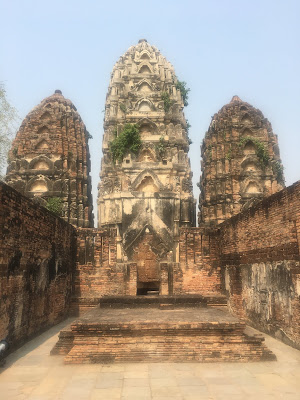We made our way to northern Thailand to the town of Sukothai to explore some ruins. Rising in the mid-13th century, Sukothai laid down much of the cultural and political groundwork for the kingdom that eventually became known as Thailand. There are 193 ancient sites here spread out amid trees, ponds, paddies and villages in several different zones.
Sukhothai Historical Park opened in 1988 and received UNESCO world heritage status three years later.
Our hotel was nice with a lovely pool to relax in when we get templed out! It was hot here and after a few hours on bikes we definitely needed that pool!
Sukhothai was a distant branch of the Khmer empire when Thai people began to migrate from the north around the 11th century. In 1238, the Thai chieftain who would become King took advantage of weakening Khmer rule and established a new kingdom, Sukhothai, a name with Sanskrit roots that translates as “Dawn of Happiness.”
In the late 13th century Sukhothai allied itself with another ambitious Thai kingdom based further north and expanded its realm across much of modern Thailand and Laos in a remarkably short period of time. For these reasons it’s often cited as the “first” Thai kingdom.
Reigning from 1279-98, Sukhothai’s most influential king is now celebrated as a founding father of the Thai nation. He’s credited with inventing the Thai alphabet, facilitating the spread of Theravada Buddhism, developing an elaborate canal system and overseeing a great blossoming of the arts. He documented the kingdom’s progress via several stone inscriptions, including one from 1292 that ranks as the oldest known example of Thai writing. After suffering an epidemic and briefly moving its capital to Phitsanulok in the 14th century, it came under the sway of a new rising star Ayutthaya. What remained of the ancient capital sat largely neglected from the late 1500s to the 1950s, when restorations began.
Wat Si Chum is located in the northern part of the monuments at Sukhothai Historical Park and was about 2 kilometes by bicycle from the center of the park.
The temple and its tall Buddha Image are among the most photographed monuments in Sukhothai. The main structure at Wat Si Chum is the Mandapa (square temple building) with a large sitting Buddha Image with the posture of Subduing Mara inside. The Buddha Image is known as Phra Ajana
Phra Ajana is 15.63 metres high and more than 11 metres wide across the knees.
Located in the North zone outside the walled city is the Wat Si Chum temple, known for its mondop with a large image of the Buddha partly visible from outside. The name of the temple translates to “temple of the Bodhi tree”. Bodhi trees are found in many temples around Thailand, because it was a Bodhi tree that the Buddha meditated under when reaching enlightenment.



























0 comments:
Post a Comment